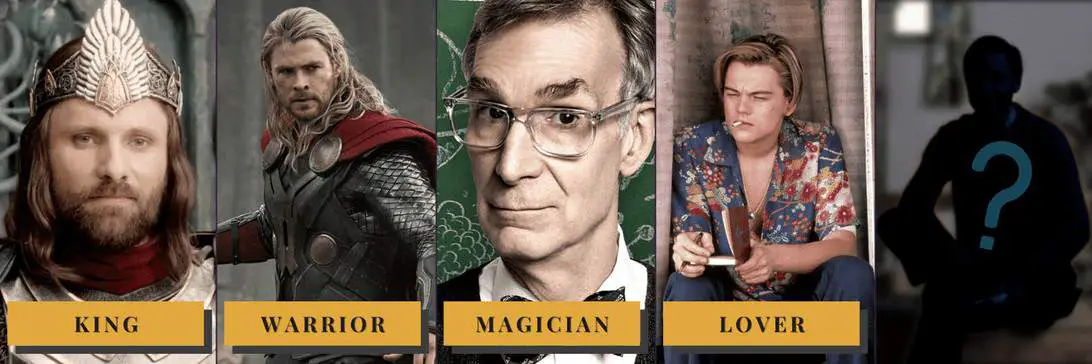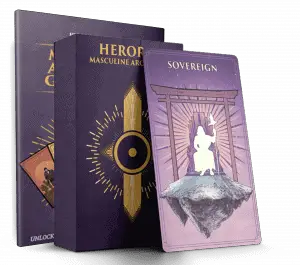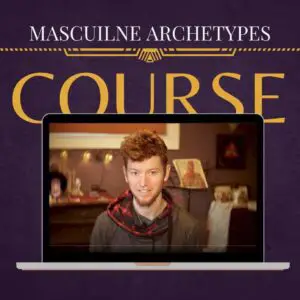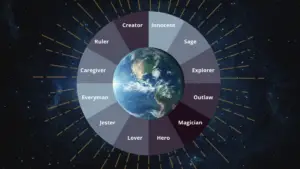Masculinity is not just one identity. There are so many aspects to who you are. It can seem like many different identities fight for dominance in our minds and bodies, but they aren’t actually separate identities—they’re just different manifestations of the masculine psyche.
In this article, you will learn how to identify the different parts of your personality and how to embrace all aspects of who you are so that no part feels like it’s being ignored or left out.
Masculine Archetypes
In King, Warrior, Magician, Lover, Robert Moore and Douglas Gillette suggested that Masculinity is made up of four Archetypes.
Archetypes are universal symbols that we all use to create meaning and understand our world. You can also think of them as tropes of Masculinity that have been around since the beginning of time.
Learn More about the theory behind Archetypes and Jungian Psychology

The Four Masculine Archetypes:
- The King (or Sovereign) provides protection, security, and order out of the chaos of the world.
- The Warrior is about action, determination, strength, and courage to battle anything that life throws at us.
- The Lover represents emotional intimacy and support. When he is balanced, the Lover can provide an empathic listening ear and offer a shoulder to cry on when needed. He has a natural empathy for others as well as being intuitive about people’s needs.
- The Magician (or Wizard) has a creative, inventive, playful energy that adds new ideas into the world.
It’s important to note that, in this model, everyone has a different blend of these energies. It’s helpful to use Archetypes to focus your attention and understand the various aspects of your psyche.
At the end of this article, I will share a fifth Masculine Archetype that I use in the Masculine Archetype Deck. It’s a good addition and brings a new level and depth to working with Masculinity.
THE KING (OR SOVEREIGN) ARCHETYPE
Harmony, Order, and Leadership

The King Archetype represents the ability to lead and take care of others. This Archetype is usually the most confident, ambitious, and self-possessed male.
The King Archetype has the ability to plan ahead to get what he wants out of life and those around him. His decisions are based on careful consideration of all his options, including risk-versus-reward scenarios, which allow him to make calculated decisions for himself as well as those around him—allowing him to make the best strategic choice for himself and his loved ones. This requires him to be studied, deliberate, and thoughtful.
This self-confidence also allows him to be compassionate, understanding of other people’s limitations as well as their potential. The King Archetype has a strong sense of direction, which helps him achieve his goals without being overly concerned with others’ opinions about living his life.
He realizes he may have moments where other people will question his decisions, but he knows that the best way to deal with those people is not to engage them. When others question him or his motives, he understands there may be some truth in what they’re saying and listens closely without getting defensive.
The negative aspects of the King are that he is often seen as aloof and detached, potentially believing that others are beneath him. This can be a result of the lack of interaction with people in his life, which creates an imbalance in self-esteem.
This disconnection also means that he has difficulty empathizing when someone else is going through difficult times or struggles to maintain their optimism when they face adversity.
The King needs to learn how to be vulnerable by being less judgmental and more emotionally available in order to connect with other people, especially the ones he cares deeply about.
Examples of the King Archetype:
- King Arthur is the golden King of a fantasy kingdom who rose from humble beginnings to lead his people and overcome many challenges, including retrieving Excalibur.
- Malcolm X was an American minister and human rights activist whose role was primarily that of a spiritual adviser to black nationalist groups. He founded Muslim Mosque, Inc. and the Organization of Afro-American Unity, which helped propagate his message to a broader audience.
- Aragorn (Lord of the Rings) was the last member of his native royal line in Gondor, but Aragorn’s humility and strength as a leader made him a powerful presence. As he led his people through the war with Sauron and defended Tolkien’s Middle-Earth, this experience tested the limits of his leadership abilities.
THE WARRIOR ARCHETYPE
Strength, Determination, and Action

The Warrior Archetype is courageous and able to persevere in the face of uncertainty and hardship. He’s not afraid to take risks and action.
He also has a strong sense of responsibility for himself and other people who depend on him. He’s willing to go above and beyond what is expected of him without being asked because it makes sense to invest in the people who depend on him for security or happiness.
The Warrior is protective over those he cares about, and he’s not afraid to fight for them with everything he has. It doesn’t matter if it is a physical or verbal confrontation; the Warrior will always come out on top.
It is important to note that the Warrior doesn’t always win. He may lose battles in his life, but he never loses himself. The Warrior knows how to pick up the pieces and continue on even after getting knocked down by an obstacle.
The Warrior is often seen as a destructive and harmful force in society. People are warned against the type of behavior that our aggressive tendencies may lead to or that we eventually end up becoming aware of it. Sometimes facing adversity requires methods beyond violence, and controlling your own emotions can be difficult at any time.
Examples of the Warrior Archetype:
- William Wallace (Braveheart) is a good representation of what it means to be a warrior. His courage and ferocity are shown when he challenges his enemies with only an ax as protection. This example shows people that even though you may lose battles, you can be a warrior and never give up.
- Michael Jordan (Basketball Player) highlights the traits of a warrior because he played hard and won games even when it was difficult sometimes. He also had such good sportsmanship that he became famous for constantly shaking hands with opponents after each game, no matter what happened in the match.
- Thor fights for what he believes in, even when it’s not popular or easy to do so. In the story, the character is in a constant battle with himself over whether violence should be used or not. By learning to understand how important peace is and when it’s necessary to use violence, he becomes worthy of wielding such a powerful weapon in the first place and learns when it’s appropriate to use physical power.
The Magician (Or Wizard) Archetype
Creativity, Ideas, Emotions

The Magician Archetype is creative, and he understands that people need a little bit of magic in their lives. He’s clever and uses that creativity in many ways to entertain others or help them solve problems. His energy is the power of thoughts, ideas, and emotions.
The Magician is more likely to be introverted and prefers time alone. He can go into a deep place where he can find himself and bring back ideas, emotions, or thoughts. He may be a more sensitive person, and the Magician energy is often in people who are poets or writers. The Magician archetype has an inner light that needs to shine outwardly and create beauty.
The Magician needs balance. He is an introvert who can get overwhelmed if not careful, and he also tends toward emotional instability. The inner light of the Magician must be tempered with the self-awareness to avoid getting carried away into what Moore calls “the abyss” or overdoing it by retreating from society too much.
The negative aspects of the Magician are that they can become so focused on their goals that they lose sight of other elements. They need to maintain balance and not get too caught up in the “doing” mode because sometimes being still or taking a break is what leads to something new.
Examples of the Magician Archetype:
- Don Draper (TV Show Mad Men) uses his mental prowess to win over clients. He is confident in how he dresses, talks, and carries himself, which gives him an air of authority that can be attractive or intimidating depending on what someone’s needs are at a given time. Don can use his intelligence and charm to get what he wants.
- Gandalf (Lord of the Rings) accomplished many feats through his mental prowess, but he often had a hard time identifying with the emotional side. He also found unique strategies through his own intuition and creativity, utilizing his charm and political process to solve problems.
- Bill Nye The Science Guy is a scientist who has spent his life studying the world around him. He is knowledgeable about everything from chemistry to astronomy and can use this knowledge to help people understand what they’re going through. Bill teaches children that science isn’t just for scientists; it’s something anyone can do if they are curious enough to learn more.
The Lover Archetype
Presence, Intimacy, and Enthusiasm

The Lover archetype is the most primal of them all and desires to be in touch with all of the senses. He is creative and aware of his surroundings, enjoying life for what it is rather than changing it.
Lovers often exhibit the power to relate to others on an emotional level and make connections quickly from those feelings. This ability also makes them prone to jealousy when betrayed or hurt by someone they love.
This can be seen in relationships where they are the one who initiates contact and seeks out emotional intimacy with their partner. Still, when it is not reciprocated, or feelings of betrayal come up, they will often feel abandoned by those who care for them most.
This Archetype’s main task is to appreciate what others give to them and be grateful for their connections. They need to reduce their tendency to compare themselves with others instead of focusing on what is good about them as individuals.
The Lover archetype’s negative aspects are that they may become too indulgent and let themselves go because there is no focus on any other achievement. This type of man may also become too dependent on their partner and not develop the strength to go out into the world by themselves or live without them.
Examples of the Lover Archetype:
- Romeo is a classic example of the Lover archetype. He falls in love with Juliet at first sight, but he doesn’t have any other interests or goals, making him very dependent on her even though she rejects his advances.
- Chiron (Moonlight) faces his sexuality and identity throughout the film, including the physical and emotional abuse he endures growing up. The film touches on his struggles with emotional connection.
- Marquis de Sade (Quills) love for others is mixed with violence and cruelty, and he often uses sex to dominate those around him. His character explores the dark side of addiction, sex, and the erotic.
- Don Quijote is a mix of King and Lover. He has an active imagination, which motivates him to go on his quests in the first place, but he’s also dependent on Dulcinea when she gives up her life for him because there was no other reason for her to go with him.
Father Archetype – The Fifth Archetype
Nurturing, Providing, Caregiving

After a decade of working with the book King Warrior Magician Lover, I found myself exploring Jung and other depth psychologists’ fundamental ideas. Over time, I began to feel as if something was missing.
I noticed that there wasn’t a space for the nurturing side of Masculinity within the four archetypes of Robert Moore and Douglas Gillette’s work. You could argue that this comes through different layers of the King and Lover, but using a fifth archetype, the Father, adds a new depth. After all, this is one of the very first archetypes we interact with as a child and one that can imprint our entire life.
The Father Archetype represents compassion, generosity, benevolence, and support. His selfless love encourages the potential of others. He shares his gifts without the need for payment or recognition. He is an advisor, healer, leader, and provider.
At his core, the Father seeks safety and security for those he loves. He makes personal sacrifices to create a supportive environment. It can be a lonely and underappreciated role, but the father archetype provides safety for others in their masculine journey.
A man who embraces his Father’s energy will typically find himself as a protector of others while also being strong enough to receive support from them when needed.
When a Father Archetype is present, he can provide the safe space needed for his children and/or community in their masculine journey.
Examples of the Father Archetype:
- Dumbledore carried the energy of the Father Archetype by protecting Harry and his friends from Voldemort. He was very supportive and caring to all of his students and created a safe place to discover who they are, Harry, Malfoy, or Neville.
- Martin Luther King Jr. is a prime example of the father archetype because he sacrificed his own life for the sake of a more significant cause. His message of Lover, protection, and compassion helped inspire a movement that is still resonating today.
- Mr. Rogers was a gentle and caring soul. He provided both protection and guidance for his viewers and allowed them to step out of their comfort zone by being himself on screen.
Conclusion: Finding Balance
When working with these five (or four) Masculine Archetypes, it’s essential to find a balance to have a fulfilling life.
To review, the Masculine Archetypes are:
- King – leader of the pack
- Warrior – strong and driven
- Magician – an expert at his craft
- Lover – a charmer and a seducer
- Father – nurturing and caregiving
A strong and prosperous man at being the King can also be unkind, crude, or insensitive to those around him if he doesn’t also embrace the Lover Archetype. A nurturing and sensitive man may neglect his own needs if he doesn’t develop the Warrior Archetype.
A man needs to find a balance between these energies.
Masculinity is multifaceted. Men often find themselves bouncing back and forth between different archetypes. If you spend the time recognizing, cultivating, and wilding the archetypes with you, you will step up to living life as a fulfilled masculine being.
I created the HeroRise Masculine Archetype Deck to help men (and anyone regardless of gender) connect to the Masculine Archetypes. Check out the deck and learn more about this powerful tool of self-development.
If you would like to further explore Masculine Archetype, check out The Masculine Archetype Deck. It gives you a tangibly way to explore your psyche and break free from unhealthy patterns.
- 47 cards and in-depth guidebook
- Five Masculine Archetypes
- Shadow Aspects
- Hero’s Journey cards





